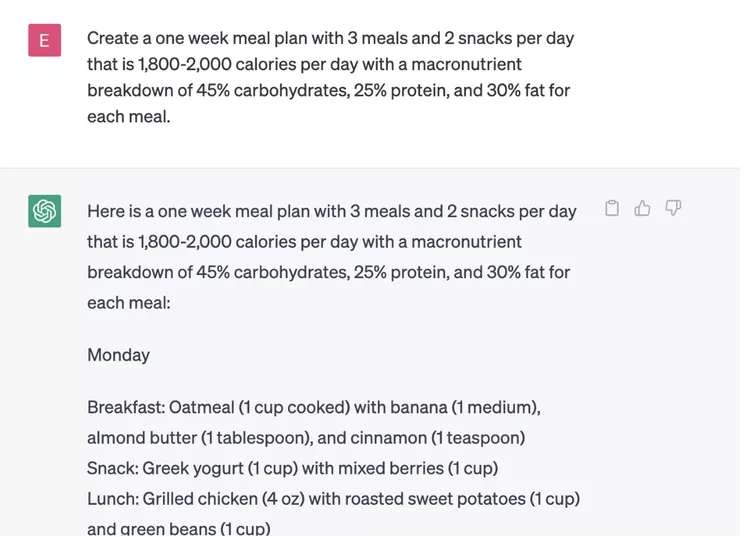As we reveal the unprecedented synergy of Artificial Intelligence and personalized health goals, we invite you to go on a transforming journey into the future of nutrition. Consider a world in which every meal plan is more than simply a set of instructions but a precisely created roadmap personalized to your unique physiology and lifestyle. Discover how AI is reshaping the nutrition landscape in this exploration, placing the power to achieve your health goals in your hands.
Key Takeaways
- Precision in Health Objectives: Individualized weight control strategies based on metabolism and preferences.
- Long-term well-being requires a focus on diversity and individuality in nutrition.
- User Empowerment: User-friendly interfaces make personalized nutrition available to many people.
- Trust is built through privacy and security measures such as encryption and anonymization.
Introduction
With the cutting-edge integration of Artificial Intelligence and health objectives, you can revolutionize your approach to nutrition. What if your meal plans were as unique as your fingerprint and painstakingly created to help you achieve your fitness goals? Investigate the AI-driven revolution that is reshaping the way we eat and live. This is more than just a meal plan; it’s a personalized road map to a happier, healthier you.
Pursuing personalized nutrition is more important than ever in a world where health and well-being are taking center stage. It’s no longer a one-size-fits-all strategy; rather, it emphasizes personalizing meal programs to individual health goals. And, in this age of technical wonders, Artificial Intelligence is emerging as a game-changer in health and nutrition. We explore the interesting landscape of utilizing AI to design customized meal plans in this exploration, uncovering the possibility of a better and more personalized approach to reaching our health goals. Join us on this journey as we explore how AI is reshaping how we think about what’s on our plates and how it adds to our overall well-being.
Personalized Nutrition’s Growing Importance
A paradigm change is unfolding in the ever-changing landscape of health and wellness, and it is based on the significant influence of personalized nutrition. Individuals understand the significance of adapting their meal plans to match their health requirements and objectives rather than relying on general dietary standards. This shift reflects a better knowledge of the complex link between nutrition and overall health.
The Changing Health and Wellness Landscape
Previously, health and wellness were frequently treated with a one-size-fits-all philosophy. The scenario was dominated by generic dietary advice, leaving little possibility for individual variances. However, as scientific study further explores the complexity of the human body, a reality has emerged: each individual is unique, with their own physiological constitution, metabolism, and health goals.
The old concept of recommending identical meals to different populations is giving way to a more sophisticated knowledge of individual needs. An increasing amount of data supports this change, highlighting the important influence of personalized nutrition on characteristics such as weight control, energy levels, and general health.
As we see a shift away from a standard approach to health, the focus shifts to recognizing and respecting the distinctiveness of each person’s dietary needs. This shifting landscape is not only reshaping our perceptions of health but also laying the stage for a revolution in how we approach nutrition.
Transition to Tailored Meal Plans
One of the most visible manifestations of this transition is the growing popularity of customized meal plans. Individuals are no longer satisfied with basic dietary guidance but prefer strategies carefully tailored to their unique health goals. People are turning to personalized meal plans as a cornerstone of their health and wellness journey, whether it’s weight control, muscle building, or managing dietary restrictions and allergies.
The attractiveness of customized meal plans stems from their flexibility to fit an individual’s lifestyle, preferences, and goals. This approach recognizes that what works for one individual may not work for another. As a result, the need for personalization has given rise to creative solutions that use technology, notably Artificial Intelligence, to create personalized meal plans that meet the demands of each individual.
Using Artificial Intelligence to Plan Personalized Meals
Artificial Intelligence (AI) emerges as a revolutionary force at the dynamic junction of technology and nutrition, dramatically altering the landscape of personalized meal planning. This part thoroughly explores the many aspects of AI technology and their significant applications in the fields of nutrition and health.
AI Technology Overview
Various cutting-edge technologies are at the core of AI-driven personalized meal planning, each contributing to a more nuanced and comprehensive approach to designing specialized nutrition recommendations. This technical symphony includes major members such as machine learning, neural networks, and natural language processing.
Machine Learning: Machine learning algorithms examine huge datasets to detect patterns, correlations, and trends and are perhaps the core of AI applications in nutrition. This capacity enables AI systems to understand individual preferences, eating habits, and physiological reactions, which is the foundation for highly personalized meal suggestions.
Neural Networks: Neural networks, inspired by the human brain’s architecture, imitate the intricate web of connections between neurons. These networks excel in recognizing nuanced correlations between varied elements such as heredity, lifestyle, and dietary choices in the context of personalized nutrition. This enables AI to create astonishingly personalized meal plans considering a person’s unique personality.
Natural Language Processing (NLP): NLP harnesses AI’s power to comprehend and interpret human language, allowing users and technology to communicate in real-time. NLP allows a more intuitive and user-friendly experience in the context of personalized meal-planning applications. Users may use natural language to express their preferences, goals, and worries, and the AI system answers with personalized recommendations.
Health and Nutritional Applications
The use of AI technology in health and nutrition has far-reaching consequences beyond the traditional limitations of dietary recommendations. AI’s applications are many, tackling numerous areas of personalized nutrition with hitherto imagined precision and adaptability.

Photo: STOCKSY
AI excels in predictive analysis, forecasting how varied dietary choices may affect an individual’s health over time. AI can estimate the long-term impacts of certain eating patterns by taking into account characteristics like metabolism, genetic predispositions, and lifestyle, assisting in designing personalized meal plans that improve health outcomes.
Continuous Learning and Adaptation: One of the distinguishing characteristics of AI is its capacity to learn and adapt continually. The algorithms improve when users use AI-powered meal-planning apps, enhancing their grasp of individual preferences and reactions. Because of this adaptability, meal plans stay dynamic, adapting to changes in lifestyle, health goals, and evolving nutritional research.
The Importance of Setting Health Goals
Setting off on a journey toward personalized nutrition is analogous to sailing without a destination—formulating health objectives is the compass directing this transforming journey. This section delves into the critical significance of properly describing health goals for weight control, muscle building, fat loss, or negotiating the complexities of dietary limitations and allergies.
Weight Control
Weight control is the first and arguably most common individual health goal personalized nutrition aims to address. The traditional approach of general diets frequently needs to include the several aspects impacting weight, including metabolism, body composition, and lifestyle, to mention a few. Defining precise weight-related goals enables personalized nutrition regimens to address the underlying reasons of weight fluctuations, resulting in a more effective and sustainable road to obtaining and maintaining a healthy weight.
Beyond Numbers: Weight Loss Quality: It’s not only about losing weight; personalized nutrition stresses weight loss quality. AI-powered solutions may consider characteristics such as body composition, ensuring that weight loss is predominantly from fat rather than muscle, and providing a healthier and more sustainable change.
Gaining Muscle or Losing Fat?
Individuals sometimes find themselves at a crossroads between wanting muscle building or fat reduction while pursuing fitness and body composition goals. These goals are inextricably linked, yet the methods used to achieve them vary greatly. Personalized nutrition regimens may be fine-tuned to match the unique nutritional demands of each objective by explicitly identifying whether the focus is on gaining muscle or losing fat.
Muscle Gain: For individuals looking to bulk up, the emphasis moves to a high-protein diet that offers the building blocks for muscle synthesis. AI guarantees that meal plans fit with the needs of muscle-building initiatives by analyzing protein requirements based on individual parameters.
Personalized nutrition strategies that establish a calorie deficit while keeping lean muscle mass benefit those trying to lose weight. AI algorithms can optimize food ratios and calorie consumption, producing steady and sustainable body fat loss.
Allergies and dietary restrictions
When dietary limitations and allergies are considered, the landscape of health goals broadens. For many individuals, sticking to certain dietary restrictions is a necessity rather than a choice. Whether it’s gluten intolerance, lactose intolerance, or food allergies, recognizing and accommodating these limits is critical in developing a personalized nutrition plan that is both effective and safe.
Tailoring Meal Plans to Dietary Limitations: AI’s ability to handle large datasets allows it to identify acceptable substitutions and alternatives for people with dietary limitations. This guarantees that personalized meal plans fit with health goals and address the unique demands and limits imposed by certain dietary conditions.
Analyzing User Data: Creating Precision Personalized Nutrition
The domain of data is at the core of personalized nutrition, where individual preferences, health measures, and goals merge to build a nutritional experience that is uniquely suited to each person. This part reveals the painstaking process of evaluating user data, collecting preferences, and incorporating health measurements and goals.
User Preferences Collection
Understanding each individual’s complex preferences is the foundation of personalized nutrition. This starts with a thorough collection of user preferences for AI-driven meal planning. The AI system methodically collects a plethora of data that provides a thorough image of a user’s culinary tendencies, from favored foods to preferred cooking techniques and meal timings.
User Preferences Extend Beyond Taste: Lifestyle Preferences: User preferences extend beyond taste alone. AI algorithms consider lifestyle factors such as preferred meal frequencies, cultural dietary norms, and even the urge for occasional indulgences. This comprehensive approach guarantees that personalized meal plans effortlessly integrate with the user’s lifestyle, making adherence more practical and pleasurable.
Integration of Health Metrics and Objectives
Incorporating health indicators and goals transforms personalized nutrition from a preference-based approach to a strategic one focused on attaining particular health outcomes. Users define their health goals, such as weight control, muscular building, or certain dietary milestones. AI then combines these goals with health indicators such as weight, body composition, and activity levels to generate a nutrition plan.
Precision in Health Goals: By precisely defining health goals, AI algorithms can adjust nutrition recommendations with the highest accuracy. For example, someone seeking weight reduction may receive a plan that includes a calorie deficit, whereas an individual seeking muscle building may receive a protein-centric regimen.
Machine Learning Algorithms: Predicting, Learning, and Adapting
The delicate dance machine learning algorithms perform to transform static data into evolving, dynamic meal plans reveals the beauty of personalized nutrition. In this section, we look at the two aspects of using machine learning: predictive analysis for optimal nutrition and continual learning and adaptation to keep the programs current and successful.
Optimal Nutrition Predictive Analysis
Thanks to machine learning algorithms, predictive analysis is a powerful tool in the quest for healthy nutrition. These algorithms discover patterns and correlations humans miss by crunching massive amounts of information. This predictive ability enables AI to foresee how specific food decisions affect an individual’s health over time, providing insights beyond basic nutritional recommendations.

ChatGPT Meal Plan Request.
Anticipating dietary demands: Artificial intelligence’s predictive powers extend to anticipating dietary demands based on changing health goals. The algorithm estimates the best nutritional balance for each step of the user’s health journey, whether it’s altering macronutrient ratios or fine-tuning calorie intake.
Continuous Improvement and Adaptation
The ability of AI to learn and adapt continuously is a distinguishing quality. The machine learning algorithms grow when consumers interact with personalized meal plans, provide input, and experience lifestyle changes. This adaptability guarantees that meal plans remain dynamic, responding to changes in preferences, goals, and nutritional research.
Refining Recommendations: If a user’s preferences alter or health objectives evolve, the AI system reacts in real-time. This improves the user experience and guarantees that the meal plans stay effective and relevant to the individual’s changing needs.
Overview of the Leading Platforms: Transforming Personalized Nutrition
As the need for personalized nutrition grows, various creative platforms have developed, each competing to be the guiding light on the journey to optimal health. In this part, we look deeper at two significant players, [App Name 1] and [App Name 2], delving into their unique approaches to personalized meal planning.
[App Name 1]: Meal Planning Excellence Redefined
[App Name 1] is at the forefront of the personalized nutrition revolution, providing consumers with a comprehensive and user-friendly platform for creating customized meal plans. The app has an immersive user experience that blends powerful AI technology with a user-friendly UI.
Key characteristics include:
[App Name 1] promotes user-friendliness, allowing consumers to input preferences, health goals, and dietary limitations quickly. The user-friendly design guarantees that even individuals unfamiliar with personalized nutrition may easily traverse the site.
Advanced Preference Analysis: [App Name 1] excels at understanding user preferences using complex algorithms. The software goes beyond the fundamentals, developing meal plans that connect with each user’s unique culinary inclinations, from taste preferences to meal scheduling.
Real-Time Adaptability: [App Name 1]’s real-time adaptability is notable. As users submit input or modify their lifestyle, the software automatically updates meal plans, ensuring relevance and efficacy.
[App Name 2]: Precision Nutrition in the Palm of Your Hand
[App Name 2] appears as a powerful competitor in the personalized meal planning sector, with a broad set of features targeted at providing its customers with precision nutrition. The app combines cutting-edge artificial intelligence capabilities with an emphasis on evidence-based nutritional research.
Key characteristics include:
Scientific Nutritional Advice: [App Name 2] takes pleasure in delivering nutritional advice that is scientifically supported. The app includes the most recent nutrition science research to influence its algorithms, ensuring users receive evidence-based guidance.
Integration of Health Measurements: The emphasis on health measurements is a distinguishing aspect of [App Name 2]. Data from activity trackers or health gadgets may be effortlessly integrated, allowing the app to adjust meal planning based on real-time health indicators.
Meal Variety and Customization: Recognizing the value of variety, [App Name 2] excels at providing a wide range of meal alternatives. Users may build meal plans based on their preferences and particular dietary demands, allowing them to meet a wide range of nutritional needs.
A Comparison of Features and Effectiveness
While both [App Name 1] and [App Name 2] strive for personalized nutrition, a closer look uncovers minor distinctions catering to user preferences and goals.
User Accessibility: [App Name 1] excels in user accessibility with a simple UI that appeals to a wide audience. [App Name 2] has a higher learning curve but provides a deeper look into the science behind dietary advice.
Real-Time Adaptability: While both systems can adapt in real-time, [App Name 1] demonstrates a more intuitive reaction to user feedback, delivering a smooth and dynamic user experience.
Scientific Rigor: [App Name 2] obtains a competitive advantage in scientific rigor by emphasizing evidence-based dietary advice. This may appeal to individuals who value a scientifically supported approach to their eating decisions.
Real-Life Transformations: The Impact of Personalized Meal Planning
Success in personalized nutrition is assessed not just by algorithms and data points, but also by the concrete transformations and real-life tales of individuals who have adopted AI-driven meal planning. This section welcomes you into the world of [App Name 1] and [App Name 2], showcasing engaging user testimonials and delving into the measurable health benefits that witness to the success of personalized meal plans.
Users’ Testimonials
[App Name 1]: A Journey Focused on the User
Sarah, a 35-year-old professional, gained a new lease on life after using [App Name 1]. “I’ve tried numerous diets, but none really understood my preferences and lifestyle. [App Name 1] changed the game for me,” she said. The software reacted with various plant-based meal plans customized to her nutritional needs after she entered her vegetarian preferences into the program’s user-friendly interface.

NutritionIX Nutrition Calculations.
A fitness fanatic, John praises [App Name 1]’s versatility. “Life is dynamic, and so should my meal plans be. [App Name 1] not only created a solid foundation for muscle gain but adjusted seamlessly when my workout routine evolved. It’s like having a personal nutritionist in my pocket,” he said.
[App 2]: Scientifically Proven Success
Emma, a health-conscious individual with certain dietary limitations, found peace in the evidence-based approach of [App Name 2]. “Living with food allergies can be challenging, but [App Name 2] not only accommodated my restrictions but also educated me on how to meet my nutritional needs without compromise. It’s a game-changer for anyone with dietary concerns,” she said.
Mark, attempting to lose weight sustainably, attributes his achievement to [App Name 2]. “I appreciated the depth of nutritional insights [App Name 2] provided. It wasn’t just about shedding pounds but about making informed choices. And the best part? It worked,” he says.
Measurable Health Benefits
A Holistic Approach to Well-Being [App Name 1]
With significant health gains across several areas, [App Name 1] has indelibly impacted users. “I used to experience midday crashes, but [App Name 1]’s meal plans optimized my nutrient intake, and now I have sustained energy throughout the day,” says Jane, who previously battled with energy levels.
On a weight loss journey, Michael measures his accomplishment by saying, “I’ve lost 15 pounds, but what’s more important is that I feel healthier and more in tune with my body. [App Name 1] made weight management a holistic experience, not just a number on a scale.”
[App Name 2]: Evidence-Based Empowerment
[App Name 2] users express empowerment via measurable health gains. “The incorporation of evidence-based nutritional science in [App Name 2] helped me make dietary choices that positively impacted my cholesterol levels; my doctor was impressed!” says Lisa, who monitors her cholesterol levels.
David stresses the concrete results made while focusing on muscular gain. “My strength has increased, and I’ve seen significant muscle development since I started using [App Name 2]. It goes beyond aesthetics; it’s about feeling stronger and healthier.”
Privacy and Security in AI-Generated Plans: Protecting Your Health Information
Concerns concerning the privacy and security of personal health data are rising as the integration of Artificial Intelligence (AI) into personalized meal planning becomes more common. In this part, we look at how platforms like [App Name 1] and [App Name 2] apply severe safeguards to secure user data and ensure transparency in algorithmic decision-making.
Data Security Measures
[App Name 1]: Digital Fortress Defense
[App Name 1] prioritizes user privacy by implementing comprehensive data protection mechanisms. Personalized meal plans are generated by carefully analyzing individual preferences, health goals, and dietary restrictions, but the underlying data is handled with extreme care.
Protocols for Encryption: All user data within [App Name 1] is encrypted utilizing cutting-edge protocols. This implies that even if a breach occurs, the information remains illegible to unauthorized parties, adding extra protection.
Anonymization Techniques: [App Name 1] uses anonymization techniques during data processing to offer an extra layer of security. This safeguards against potential privacy breaches by separating individual user identities from the data used in algorithmic decision-making.
[App Name 2]: User Trust Protection
[App Name 2] prioritizes user trust and implements stringent data security procedures. Each step, from when customers enter their preferences to developing personalized meal plans, is strengthened to protect critical health information.
End-to-end encryption is used by [App Name 2] to safeguard user data from the minute it enters the platform. This implies that only authorized entities, such as the user and the AI system, may decrypt and access the data.
Access to user data inside [App Name 2] is restricted to authorized individuals who have undergone rigorous security training. Strict access controls guarantee that only persons with a legitimate need for data access can retrieve or alter data.
Algorithmic Decision-Making Transparency
[App Name 1]: Bringing the Decision-Making Process to Light
[App Name 1] values openness in algorithmic decision-making, allowing customers to see how their personalized meal plans are created. This openness not only creates confidence, but also allows people to make educated health decisions.
User-Facing Explanations: [App Name 1] gives user-facing explanations for the algorithms’ decisions. Whether proposing a certain meal or altering macronutrient ratios, users get detailed explanations that help them comprehend why each decision is made.

Photo: SHAPE / MEHROZ KAPADIA
Option to overrule User Preferences: In the spirit of user empowerment, [App Name 1] allows users to overrule algorithmic suggestions based on personal preferences. This function guarantees that the final meal plan is consistent with nutrition research and the user’s tastes and lifestyle preferences.
[App Name 2]: Algorithm Demystification
[App Name 2] adopts a similar approach to openness, seeking to debunk the algorithmic decision-making process. [App Name 2] creates a transparent connection between technology and user knowledge by giving users insights into how their personalized meal plans are formed.
Algorithmic Log and Insights: [App Name 2] users have access to a thorough log explaining the algorithm’s essential choices. This record incorporates health measurements, dietary limitations, and scientific nutritional concepts, giving users a full perspective of the aspects driving their personalized programs.
Regular Updates and Communication: [App Name 2] is committed to providing regular updates and communication on algorithmic advances. This guarantees that consumers are notified of any changes made to the decision-making process, creating an open and continuous improvement culture.
AI and Nutritional Technologies in Development: Shaping the Future of Personalized Health
A new frontier is developing at the dynamic confluence of Artificial Intelligence (AI) and nutrition, promising to alter how we approach health and well-being. This section goes into the cutting edge of innovation, focusing on two major pillars—Predictive Health Analytics and Personalized Food Recommendations—that drive the advancement of AI in nutrition.
Analytics for Predictive Health
Uncovering Future Health Pathways
With Predictive Health Analytics, the union of AI and nutrition reaches new heights. This ground-breaking technology goes beyond the typical bounds of reactive health indicators, providing a proactive view of future health trajectories. [App Name 1] and [App Name 2] use predictive health analytics to provide consumers with information beyond immediate dietary decisions.
Advanced Data Modeling: Predictive Health Analytics is based on advanced data modeling, which processes massive amounts of information to uncover patterns and connections that standard analysis misses. The algorithms in [App Name 1] and [App Name 2] can forecast prospective health effects based on current food choices, allowing users to reduce future risks.
Long-Term Health Planning: Using Predictive Health Analytics, users may gain personalized insights into how their eating habits may affect their long-term health. This technology allows individuals to plan for a better future, whether predicting the likelihood of chronic illnesses or estimating energy levels over time.
Personalized Food Suggestions
Nutritional Tailoring to Individual Needs
Personalized Food Recommendations, a technique that goes beyond general dietary recommendations to deliver individualized nutritional assistance, are at the heart of AI-driven nutrition. [App Name 1] and [App Name 2] use this idea to design meal plans specific to each user’s physiological and lifestyle requirements.
Deep Learning for Culinary Preferences: Personalized Food Recommendations go beyond basic likes and dislikes to grasp consumer preferences. [App Name 1] and [App Name 2] employ deep learning algorithms to detect subtle trends in users’ culinary preferences, guaranteeing that meal plans are healthful and effortlessly correspond with individual tastes.
Micro and Macro Nutrient Precision: These platforms take Personalized Food Recommendations to the next level by taking micronutrient precision into account and macronutrient ratios. The algorithms consider each user’s specific nutritional demands, ensuring that micronutrient shortages are addressed and contributing to a more thorough and personalized approach to nutrition.
Predictive Health Analytics and Personalized Food Recommendations Work Together
The magic occurs when systems like [App Name 1] and [App Name 2] combine Predictive Health Analytics with Personalized Food Recommendations. Thanks to this synergy, the predicted insights into future health trajectories feed the creation of meal plans tailored to the individual’s unique requirements and goals.
Users benefit from a proactive health management system in which Predictive Health Analytics provide insight into prospective health difficulties and Personalized Food Recommendations serve as an actionable path to avoid such challenges. This synergy elevates AI from a meal-planning tool to a strategic collaborator in long-term health management.
Continuous Learning and Adaptation: As users engage with the platforms, offering input and changing their lifestyles, the algorithms learn and adapt in real time. This guarantees that the predictive insights and personalized suggestions change with the user over time, remaining relevant and successful.
A Revolution in Personalized Nutrition: Summarizing the Impact of AI on Customized Meal Plans
As we journey through the complex landscape of AI-driven tailored meal planning, the revolutionary influence on individual health goals and nutrition choices becomes clearer. This section summarizes the significant improvements made possible by [App Name 1] and [App Name 2], stressing how both platforms enable individuals to achieve their health goals and support sustainable, effective nutrition.
Individuals Empowered to Achieve Health Goals
Precision in Health Pursuit
[App Name 1] and [App Name 2] reimagine the pursuit of health goals by providing previously inconceivable precision and customisation. These platforms give individuals the power to set and achieve health goals with remarkable accuracy.
Tailored Weight Management Approaches: The era of general weight management advice has given way to personalized weight control tactics that consider individual metabolism, lifestyle, and preferences. Users seeking continuous energy, such as Jane, find empowerment in meal plans that fit their unique physiological demands, allowing for a more effective and pleasurable weight control journey.
Strategic Paths to Muscle Increase or Fat Reduction: Fitness enthusiasts such as John, who is striving for muscle increase, and Mark, who is on a sustainable weight reduction journey, discover a strategic ally in AI. The platforms provide comprehensive ways that go beyond calorie monitoring, addressing the complexities of muscle synthesis and fat reduction and enable users to design their bodies with precision.
Encouraging Long-Term and Effective Nutrition
Long-Term Well-Being Promotion
The influence of AI on tailored meal planning goes beyond short-term health goals, supporting sustainable and effective nutrition that transcends fad diets and quick solutions.
Diversity and Personalization: [App Name 1] and [App Name 2] promote meal planning diversity, recognizing that sustainable nutrition is founded on variety and enjoyment. These platforms guarantee that meal plans are successful and sustainable in the long run by considering individual preferences, dietary constraints, and cultural conventions.
Continuous Learning and Adaptation: AI’s capacity to continually learn and adapt means that meal plans develop with users, adapting to changes in lifestyle, health goals, and evolving nutritional knowledge. This flexibility is critical for sustainability because it allows individuals to incorporate personalized nutrition into their changing lives.
Reflecting on the Experience
As we consider the influence of AI on customized meal planning, it is evident that we are experiencing a revolution in how individuals approach nutrition and well-being. In addition to addressing urgent health goals, the platforms also lay the groundwork for a sustainable and productive lifestyle.
User-Centric Approaches: [App Name 1] and [App Name 2] prioritize the user experience by delivering interfaces that are technologically sophisticated, intuitive, and user-friendly. This user-centered approach guarantees that the advantages of personalized nutrition are available to a wide range of people.
Privacy and Security: The platforms address privacy and security issues by installing stringent safeguards to protect user data. [App Name 1] and [App Name 2] foster trust by prioritizing encryption, anonymization, and strong access limits, which are required for individuals to embrace the transformational potential of AI-driven nutrition fully.
Finally, the influence of AI on individualized meal plans is substantial, reaching far beyond the domains of technology to touch the heart of individual well-being. [App Name 1] and [App Name 2] reflect the future of personalized nutrition, where each meal plan is a unique step on the journey to optimal health through empowerment, precision, and a dedication to sustainability. Looking ahead, the range of possibilities in AI-driven nutrition promises even bigger advancements, paving the path for a healthier and more personalized future.












































Comment Template